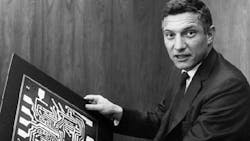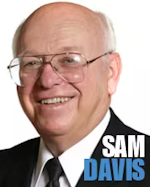Fairchild Semiconductor, once home to the brightest minds in the fledgling semiconductor industry, is going through its latest corporate redirection–being purchased by ON Semiconductor, a one-time Motorola spinoff. Phoenix, Ariz.-based ON Semiconductor Corp. will buy Fairchild Semiconductor International Inc., San Jose, Calif., for $2.4 billion to bolster its business of making power-management ICs. The combined company will have annual revenue of $5 billion, with revenue overlap of less than $100 million and little product overlap, said Keith Jackson, CEO of ON Semi, which had revenue of $3.16 billion in 2014.
An industry analyst noted that ON Semi’'s move to get Fairchild most likely was meant to keep it out of the hands of a competitor, such as China’s Tsinghua Unigroup Ltd., which has its sights on becoming the world’s No. 3 chipmaker.
Industry analyst Christopher Rolland said Tsinghua would “probably be top of the list” of firms that ON Semi’s move was aimed to thwart. China’s Tsinghua has spent more than $9.4 billion in two years, including buying a stake in U.S. data-storage company Western Digital Corp., and with plans to invest $47 billion over the next five years.
Epicenter of Semiconductor Industry
Actually, the Fairchild story began in 1956 when Silicon Valley was just emerging. William Shockley (inventor of the transistor) opened one of the first Silicon Valley companies, Shockley Semiconductor Laboratory. First, Shockley tried to hire some of his colleagues from Bell Labs, but they didn’t want to move to the West Coast and work for Shockley. Instead, Shockley hired some of the best and brightest graduates from West Coast colleges.
Shockley’s core group included Julius Blank, Victor Grinich, Jean Hoerni, Eugene Kleiner, Jay Last, Gordon Moore, Robert Noyce, and Sheldon Roberts. “The Group” became disenchanted with Shockley’s management style and turned to Sherman Fairchild’s Fairchild Camera and Instrument as a savior. This led to the birth of the Fairchild Semiconductor division in 1957. At that time, germanium was the most common material for semiconductors. Instead, Robert Noyce, who became co-founder and general manager of Fairchild Semiconductor, advocated silicon as a substrate.
Fairchild’s Noyce and Texas Instruments’ Jack Kilby had independently invented the integrated circuit. In 1960, Noyce invented the planar integrated circuit, which was patented on April 25, 1961. The first device employed resistor-resistor logic for a set/reset flip-flop that had the honor of being the industry’s first integrated circuit available as a monolithic chip.
The industry preferred Fairchild’s invention over Texas Instruments’ because the transistors in silicon planar ICs were interconnected by a thin film deposit, whereas Texas Instruments’ invention needed fine wires to connect individual germanium circuits. Plus, Noyce’s invention was enabled by a planar process developed by Jean Hoerni. Its original headquarters were in Silicon Valley, but in 1962 Fairchild moved to a facility in South Portland, Maine, that included manufacture, test, and assembly of transistors.
In the early 1960s, Fairchild R&D began development of MOSFET (metal-oxide-semiconductor field-effect transistor) technology, which had been pioneered by RCA and Bell Labs. The experiments led to Fairchild's development of MOS integrated circuits.
Some of the key dates in Fairchild Semiconductor’s history:
1957: Fairchild Semiconductor becomes a subsidiary of Fairchild Camera and Instrument.
1963: Robert Widlar is hired to design analog operational amplifiers. Fairchild's processes were optimized for digital circuits, so Widlar collaborates with process engineer Dave Talbert to design the op amps.
1964: Robert Widlar develops first IC op amp, µA702 followed by the µA709.
1968: Fairchild introduces David Fullagar's µA741, destined to become the most popular IC op amp of all time.
1979: Fairchild Camera and Instrument becomes part of Schlumberger, an oil field services company.
1985: Fairchild Research lab forms Schlumberger Palo Alto Research (SPAR).
1987: Schlumberger sells Fairchild Semiconductor to National Semiconductor. Sale did not include Fairchild’s Test Division that designed and produced ATE systems.
1997: Fairchild Semiconductor is spun off from National Semiconductor and reborn as an independent company with headquarters in South Portland, Maine.
1997: Fairchild acquires the semiconductor division of Raytheon Corporation.
1999: Fairchild acquires Samsung’s Power Device Division that provided the company with a complete line discrete power devices and a line of analog components.
2000: Fairchild launches the Interface and Logic Group followed by the acquisitions of QT Optoelectronics, Kota Microcircuits and Micro Linear’s power management business.
2001: Acquires Intersil’s discrete power business making Fairchild the second largest power MOSFET supplier at that time. Intersil was founded by Jean Hoerni, a founding member of the original Fairchild Semiconductor.
2001: Fairchild acquires Impala Linear Corp., which provided expertise in analog power management semiconductors.
2007: Anadigics acquires Fairchild’s RF design team.
2011: Fairchild Semiconductor acquires TranSiC, a silicon carbide power transistor company based in Sweden.
2011: Fairchild Semiconductor relocates its headquarters to Silicon Valley from South Portland, Maine.
2015: ON Semiconductor in process of acquiring Fairchild Semiconductor
Among Fairchild Semiconductor technological achievements:
1963: Dual gate device for a second generation RTL product
1964: NPN planar power transistor incorporating a thin film emitter resistor process
1964: First Op Amp, a milestone in linear ICs
1966: First standard TTL product, a quad two-input NAND gate.
1968: New Op Amp that is one of earliest linear ICs to include temperature compensation and MOS capacitors
1973: First functional device with dielectric isolation of both emitter-base and base-collector junctions
1978: FAST (Fairchild Advanced Schottky TTL) logic launched that offers a 20 to 30% performance improvement over the original isoplanar technique
1985: FACT logic attains superior speed while retaining the low power consumption of CMOS
1986: First CMOS non-volatile electrically erasable memory
1989: FACT Quiet Series to control output overshoot, undershoot and EMI
1990: EEPROM built with alternate metal ground (AMG)™ architecture, resulting in a smaller die
1991: 300 Series ECL, the easiest to use ECL logic providing fast gate speeds, full voltage and temperature compensation
1993: First HC-replacement, low noise, high-speed CMOS logic
1994: CROSSVOLT LCX low voltage logic with 3.3V operation
1996: TinyLogic performance similar HC/VHC for CMOS and TTL
1998: Arithmetic Controller Engine (ACEx) 8-bit microcontroller for low power and high performance
2000: First MOSFET BGA package allows a wide range of footprints.
2003: FSBB20CH60 smart power module for three-phase inverter.
2010: 25V MOSFET with low RDS(ON) in MLP package.
2010: Smallest and thinnest wafer-level chip-scale N-channel device
ON Semiconductors mergers and acquisitions:
1999: Spinoff from Motorola
2000: Acquires Cherry Semiconductor
2006: Acquires LSI Logic’s design and manufacturing center in Gresham, Oregon
2007: Acquires ADI Voltage Regulation and Thermal Management Group
2008: Acquires Catalyst Semiconductor
2008: Acquires AMI Semiconductor
2009: Acquires PulseCore Semiconductor
2010: Acquires Sound Design Technologies
2010: Acquires California Micro Devices
2011: Acquires Sanyo Semiconductor
2011: Acquires Cypress Image Sensor Business
2014: Acquires Aptina Imaging
2014: Acquires Truesense Imaging, Inc,
2015: Acquires AXSEM
2015: In process of acquiring Fairchild Semiconductor
Fairchild Semiconductor’s list of alumni reads like a Who’s Who in Semiconductors:
- Gil Amelio
- Lee Boysel
- Wilfred Corrigan
- Alan L. Davis
- James M. Early
- Federico Faggin
- Andrew Grove
- Peter E. Hart
- Jean Hoerni
- Lester Hogan
- Eugene Kleiner
- Richard Lyon
- Gordon Moore
- Robert Noyce
- Chih-Tang Sah
- Jerry Sanders
- Robert Swanson
- Ed Turney
- Leslie L. Vadász
- Frank Wanlass
- Bob Widlar
- Andrew Witkin
- Don Valentine
- Bernard A Yurash


